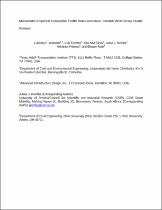 ResearchSpace
ResearchSpace
Mechanistic-empirical compatible traffic data generation: Portable WIM versus cluster analysis
JavaScript is disabled for your browser. Some features of this site may not work without it.
- ResearchSpace
- →
- Research Publications/Outputs
- →
- Journal Articles
- →
- View Item
| dc.contributor.author |
Walubita, LF

|
|
| dc.contributor.author |
Fuentes, F

|
|
| dc.contributor.author |
Faruk, NM

|
|
| dc.contributor.author |
Komba, Julius J

|
|
| dc.contributor.author |
Naik, B

|
|
| dc.contributor.author |
Prakoso, A

|
|
| dc.date.accessioned | 2020-10-12T07:32:18Z | |
| dc.date.available | 2020-10-12T07:32:18Z | |
| dc.date.issued | 2020-05 | |
| dc.identifier.citation | Walubita, L.F. 2020. Mechanistic-empirical compatible traffic data generation: Portable WIM versus cluster analysis. Journal of Testing and Evaluation, v48(3), pp 2377-2392. | en_US |
| dc.identifier.issn | 0090-3978 | |
| dc.identifier.issn | 1945-7553 | |
| dc.identifier.uri | https://www.astm.org/DIGITAL_LIBRARY/JOURNALS/TESTEVAL/PAGES/JTE20190745.htm | |
| dc.identifier.uri | https://doi.org/10.1520/JTE20190745 | |
| dc.identifier.uri | http://hdl.handle.net/10204/11625 | |
| dc.description | Copyright: 2020 ASTM International. This is the preprint version of the work. Kindly visit the publisher's website for access to the fulltext version. | en_US |
| dc.description.abstract | Axle load distribution factors (ALDFs) are used as one of the primary traffic data inputs for mechanistic-empirical (ME) pavement design methods for predicting the impact of varying traffic loads on pavement performance with a higher degree of accuracy than empirical methods that are solely based on equivalent single axle load (ESAL) concept. Ideally, to ensure optimal pavement structural design, site-specific traffic load spectra data—generated from weigh-in-motion (WIM) systems—should be used during the pavement design process. However, because of the limited number of available permanent WIM stations (in Texas, for example), it is not feasible to generate a statewide ALDFs database for each highway or project from permanent WIM data. In this study, two possible alternative methods, namely, the direct measurement using a portable WIM system and the cluster analysis technique, were explored for generating site-specific ME-compatible traffic data for a highway test section, namely, state highway (SH) 7 in Bryan District (Texas). The traffic data were then used for estimating pavement performance using a ME pavement design software, namely, the Texas Mechanistic-Empirical Thickness Design System (TxME). The TxME-predicted pavement performance (e.g., rutting) using the portable WIM-generated traffic input parameters closely matched with the actual field performance. Overall, the study findings indicated that the portable WIM (with proper installation and calibration) constitutes an effective means for rapidly collecting reliable site-specific ME-compatible traffic data. | en_US |
| dc.language.iso | en | en_US |
| dc.publisher | ASTM International | en_US |
| dc.relation.ispartofseries | Worklist;23812 | |
| dc.subject | Traffic load spectra | en_US |
| dc.subject | Axle load distribution factors | en_US |
| dc.subject | ALDFs | en_US |
| dc.subject | Weigh-in-motion | en_US |
| dc.subject | WIM | en_US |
| dc.subject | Cluster analysis | en_US |
| dc.subject | Mechanistic-empirical | en_US |
| dc.subject | Pavement design | en_US |
| dc.title | Mechanistic-empirical compatible traffic data generation: Portable WIM versus cluster analysis | en_US |
| dc.type | Article | en_US |
| dc.identifier.apacitation | Walubita, L., Fuentes, F., Faruk, N., Komba, J. J., Naik, B., & Prakoso, A. (2020). Mechanistic-empirical compatible traffic data generation: Portable WIM versus cluster analysis. http://hdl.handle.net/10204/11625 | en_ZA |
| dc.identifier.chicagocitation | Walubita, LF, F Fuentes, NM Faruk, Julius J Komba, B Naik, and A Prakoso "Mechanistic-empirical compatible traffic data generation: Portable WIM versus cluster analysis." (2020) http://hdl.handle.net/10204/11625 | en_ZA |
| dc.identifier.vancouvercitation | Walubita L, Fuentes F, Faruk N, Komba JJ, Naik B, Prakoso A. Mechanistic-empirical compatible traffic data generation: Portable WIM versus cluster analysis. 2020; http://hdl.handle.net/10204/11625. | en_ZA |
| dc.identifier.ris | TY - Article AU - Walubita, LF AU - Fuentes, F AU - Faruk, NM AU - Komba, Julius J AU - Naik, B AU - Prakoso, A AB - Axle load distribution factors (ALDFs) are used as one of the primary traffic data inputs for mechanistic-empirical (ME) pavement design methods for predicting the impact of varying traffic loads on pavement performance with a higher degree of accuracy than empirical methods that are solely based on equivalent single axle load (ESAL) concept. Ideally, to ensure optimal pavement structural design, site-specific traffic load spectra data—generated from weigh-in-motion (WIM) systems—should be used during the pavement design process. However, because of the limited number of available permanent WIM stations (in Texas, for example), it is not feasible to generate a statewide ALDFs database for each highway or project from permanent WIM data. In this study, two possible alternative methods, namely, the direct measurement using a portable WIM system and the cluster analysis technique, were explored for generating site-specific ME-compatible traffic data for a highway test section, namely, state highway (SH) 7 in Bryan District (Texas). The traffic data were then used for estimating pavement performance using a ME pavement design software, namely, the Texas Mechanistic-Empirical Thickness Design System (TxME). The TxME-predicted pavement performance (e.g., rutting) using the portable WIM-generated traffic input parameters closely matched with the actual field performance. Overall, the study findings indicated that the portable WIM (with proper installation and calibration) constitutes an effective means for rapidly collecting reliable site-specific ME-compatible traffic data. DA - 2020-05 DB - ResearchSpace DP - CSIR KW - Traffic load spectra KW - Axle load distribution factors KW - ALDFs KW - Weigh-in-motion KW - WIM KW - Cluster analysis KW - Mechanistic-empirical KW - Pavement design LK - https://researchspace.csir.co.za PY - 2020 SM - 0090-3978 SM - 1945-7553 T1 - Mechanistic-empirical compatible traffic data generation: Portable WIM versus cluster analysis TI - Mechanistic-empirical compatible traffic data generation: Portable WIM versus cluster analysis UR - http://hdl.handle.net/10204/11625 ER - | en_ZA |





